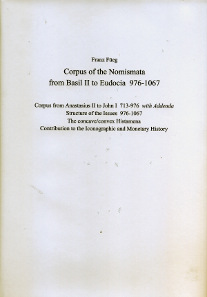by Ursula Kampmann
translated by Annika Backe
February 19, 2015 – Franz Füeg is one of the most meticulous researchers currently working on the Byzantine coinage. His new opus commands deep respect from every reader, acknowledging the care with which the author has treated the relevant material. With this impressive publication Franz Füeg provides a die corpus for the nomismata from 976 to 1067 that accesses not only the objects in museums collections but all specimens sold in auction sales as well.
Franz Füeg, Corpus of the Nomismata from Basil II to Eudacia 976-1067. Classical Numismatic Group, Lancaster (Pennsylvania) / London, 2014. 161 p., 21,3 x 29,7 cm, figures and graphics in black and white, Hardcover. CD-ROM attached. ISBN: 978-0-9898254-9-8. $125.
The diligence and the analytic intellect that are necessary to finish such a well-wrought work have to be admired in themselves. Together with his first book that dealt with the nomismata coinage from 713 to 976 (the addenda to which are part of this volume), Franz Füeg has exhaustively researched the Byzantine gold coinage except for the semisses and tremisses of the 8th and 9th centuries.
Let’s face it: anyone writing an auction sale catalog and being in a hurry to find a reference on a coin will be out of sorts with Franz Füeg. It does take some time to identify the exact coin in his work, which makes every reader realize how complex the Byzantine coinage really is – despite the fact that the author has come up with good ideas to keep the actual catalog as lean as possible. He split it into the printed book with the die variants and their descriptions and the actual catalog containing all the accessed specimens – not in a printed format but on an CD-ROM that comes with it.
The most important element to dealers and collectors, however, is Füeg’s thorough list of forgeries he had come to know (an alarming number, by the way). Thanks to his extensive die study he was able to identify several objects as forgeries that could not have been detected with conventional techniques. If only one single forgery is not being bought after checking with the new Füeg then the book is already worth its prize!
With that said, it seems hardly necessary to likewise mention the scientific commentary on the catalog that elaborates in an exemplary manner on the different aspects of the relevant coinage. It offers information on the attire and the insignia depicted on the coins, the image of Christ, the Saints and their icons. Füeg discusses in detail how the concave histamena had been made exactly and reflects about the reasons for this new production method. Particularly interesting are the interesting five pages Franz Füeg spends on what we know about the economic history of this era. A number of tables with statistical analyses conclude the work that deserves to become part of every well-assorted book case on Byzantine numismatics.
The publication of Franz Füeg is a catalog that will still be a reference work in 100 years’ time. For his first volume the Académie des Inscriptions et Belles-Lettres of the Institut de France awarded him the Prix DUCHALAIS in 2010. We are curious about how many prizes this second volume is going to win. We would award him a prize right away if we had one to give.





